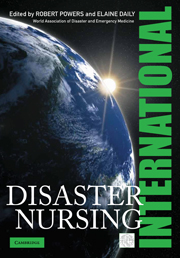Book contents
- Frontmatter
- FOREWORD I
- FOREWORD II
- Contents
- CONTRIBUTORS
- PREFACE
- ACKNOWLEDGMENTS
- CHAPTER 1 INTRODUCTION TO DISASTERS AND DISASTER NURSING
- CHAPTER 2 HEALTHCARE FACILITY PREPAREDNESS
- CHAPTER 3 COMMUNITY BEHAVIOR AND RESPONSE TO DISASTER
- CHAPTER 4 FIRST RESPONDERS
- CHAPTER 5 DISASTER TRIAGE
- CHAPTER 6 HOSPITAL IMPACT: EMERGENCY DEPARTMENT
- CHAPTER 7 HOSPITAL IMPACT: IMMEDIATE ISSUES
- CHAPTER 8 HOSPITAL IMPACT: LONG-TERM ISSUES
- CHAPTER 9 HOSPITAL IMPACT: INTERNAL DISASTERS
- CHAPTER 10 HEALTHCARE FACILITIES INCIDENT COMMAND
- CHAPTER 11 CHEMICAL PREPAREDNESS AND RESPONSE
- CHAPTER 12 BIOLOGICAL PREPAREDNESS AND RESPONSE
- CHAPTER 13 EMERGENCY MANAGEMENT OF RADIATION INJURIES AND ILLNESSES
- CHAPTER 14 EXPLOSIVE EVENT PREPAREDNESS/RESPONSE
- CHAPTER 15 DECONTAMINATION
- CHAPTER 16 POPULATIONS WITH VULNERABILITIES AND SPECIAL NEEDS
- CHAPTER 17 DISASTERS AND CHILDREN
- CHAPTER 18 REGIONAL PLANNING
- CHAPTER 19 US FEDERAL RESOURCES AND RESPONSE
- CHAPTER 20 INTERNATIONAL DISASTER RESPONSE
- CHAPTER 21 DISASTER NURSING RESPONSES IN JAPAN
- CHAPTER 22 PREPAREDNESS OF THE ISRAELI HEALTH SYSTEM FOR EMERGENCIES
- CHAPTER 23 PUBLIC HEALTH RESPONSE
- CHAPTER 24 PANDEMIC PLANNING
- CHAPTER 25 HEALTH ISSUES IN HUMANITARIAN EMERGENCIES
- CHAPTER 26 DISASTER MENTAL HEALTH
- CHAPTER 27 DISASTER ETHICS
- CHAPTER 28 DISASTER RECOVERY
- CHAPTER 29 THE SOUTHEAST ASIA TSUNAMI: HEALTH ASPECTS
- CHAPTER 30 HURRICANE KATRINA: HEALTH ASPECTS
- CHAPTER 31 DISASTER NURSING EDUCATIONAL COMPETENCIES
- CHAPTER 32 DISASTER NURSING RESEARCH
- CHAPTER 33 DISASTER RESEARCH FRAMEWORK
- INDEX
FOREWORD II
Published online by Cambridge University Press: 02 December 2010
- Frontmatter
- FOREWORD I
- FOREWORD II
- Contents
- CONTRIBUTORS
- PREFACE
- ACKNOWLEDGMENTS
- CHAPTER 1 INTRODUCTION TO DISASTERS AND DISASTER NURSING
- CHAPTER 2 HEALTHCARE FACILITY PREPAREDNESS
- CHAPTER 3 COMMUNITY BEHAVIOR AND RESPONSE TO DISASTER
- CHAPTER 4 FIRST RESPONDERS
- CHAPTER 5 DISASTER TRIAGE
- CHAPTER 6 HOSPITAL IMPACT: EMERGENCY DEPARTMENT
- CHAPTER 7 HOSPITAL IMPACT: IMMEDIATE ISSUES
- CHAPTER 8 HOSPITAL IMPACT: LONG-TERM ISSUES
- CHAPTER 9 HOSPITAL IMPACT: INTERNAL DISASTERS
- CHAPTER 10 HEALTHCARE FACILITIES INCIDENT COMMAND
- CHAPTER 11 CHEMICAL PREPAREDNESS AND RESPONSE
- CHAPTER 12 BIOLOGICAL PREPAREDNESS AND RESPONSE
- CHAPTER 13 EMERGENCY MANAGEMENT OF RADIATION INJURIES AND ILLNESSES
- CHAPTER 14 EXPLOSIVE EVENT PREPAREDNESS/RESPONSE
- CHAPTER 15 DECONTAMINATION
- CHAPTER 16 POPULATIONS WITH VULNERABILITIES AND SPECIAL NEEDS
- CHAPTER 17 DISASTERS AND CHILDREN
- CHAPTER 18 REGIONAL PLANNING
- CHAPTER 19 US FEDERAL RESOURCES AND RESPONSE
- CHAPTER 20 INTERNATIONAL DISASTER RESPONSE
- CHAPTER 21 DISASTER NURSING RESPONSES IN JAPAN
- CHAPTER 22 PREPAREDNESS OF THE ISRAELI HEALTH SYSTEM FOR EMERGENCIES
- CHAPTER 23 PUBLIC HEALTH RESPONSE
- CHAPTER 24 PANDEMIC PLANNING
- CHAPTER 25 HEALTH ISSUES IN HUMANITARIAN EMERGENCIES
- CHAPTER 26 DISASTER MENTAL HEALTH
- CHAPTER 27 DISASTER ETHICS
- CHAPTER 28 DISASTER RECOVERY
- CHAPTER 29 THE SOUTHEAST ASIA TSUNAMI: HEALTH ASPECTS
- CHAPTER 30 HURRICANE KATRINA: HEALTH ASPECTS
- CHAPTER 31 DISASTER NURSING EDUCATIONAL COMPETENCIES
- CHAPTER 32 DISASTER NURSING RESEARCH
- CHAPTER 33 DISASTER RESEARCH FRAMEWORK
- INDEX
Summary
DISASTERS OCCUR DAILY somewhere in the world and have a dramatic impact on the quality of life of individuals, families, and communities. The World Disasters Report 2007 confirmed a 60% increase in the occurrence of disasters in the last decade (1997–2006) compared to the previous decade. The number of reported deaths associated with disasters increased from 600,000 to more than 1.2 million while, at the same time, the number of people affected rose from 230 million to 270 million – a 17% increase. No nation, region, community, or individual is immune to the potential devastations of a disaster.
According to the United Nations' Bureau of Crisis Prevention and Recovery, nearly 75% of the world's population live in areas that were affected at least once by an earthquake, a tropical cyclone, flooding, or drought between 1980 and 2000. In the year 2007, 133 countries were impacted by some disaster-producing event–up from an average of 116 countries during the period 2000–2006.
Nations with less resources are particularly vulnerable and require special attention, as they are less able to finance and support disaster preparation, emergency efforts, and infrastructure reconstruction initiatives. When disaster strikes, funds are diverted from other urgently required programs. Disasters, therefore, can change the face of a resource-poor nation in minutes, wiping out years of development. Disaster reduction and sustainable development are thus closely linked.
- Type
- Chapter
- Information
- International Disaster Nursing , pp. vii - viiiPublisher: Cambridge University PressPrint publication year: 2010



